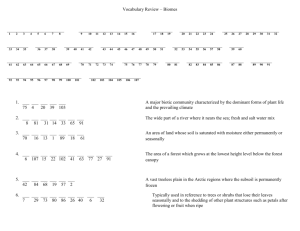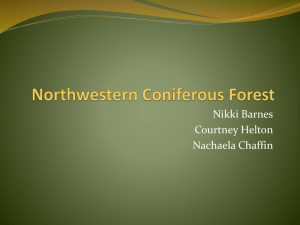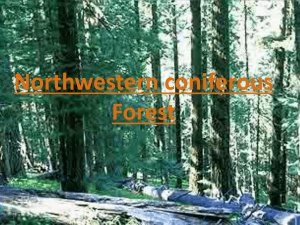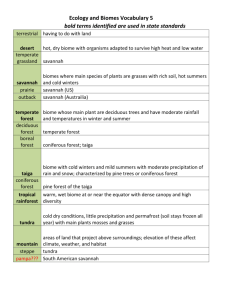northwestern coniferous forest
advertisement
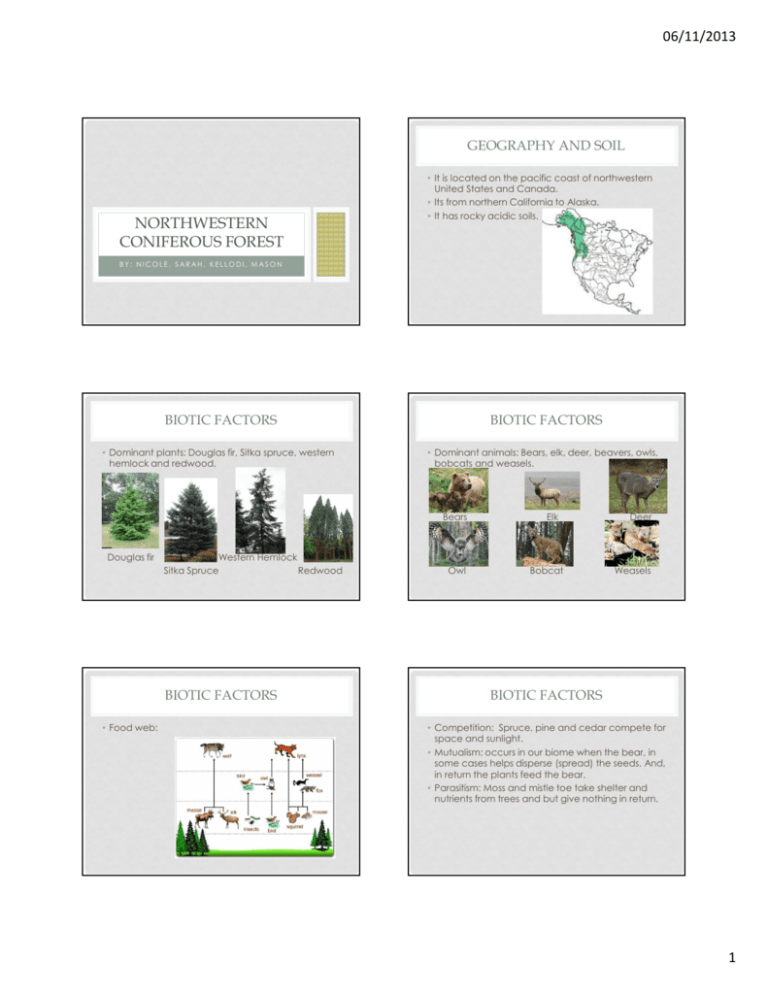
06/11/2013 GEOGRAPHY AND SOIL NORTHWESTERN CONIFEROUS FOREST • It is located on the pacific coast of northwestern United States and Canada. • Its from northern California to Alaska. • It has rocky acidic soils. BY : NICOLE, SARAH, KELLODI, MASON BIOTIC FACTORS • Dominant plants: Douglas fir, Sitka spruce, western hemlock and redwood. BIOTIC FACTORS • Dominant animals: Bears, elk, deer, beavers, owls, bobcats and weasels. Bears Douglas fir Western Hemlock Sitka Spruce Redwood BIOTIC FACTORS • Food web: Owl Elk Bobcat Deer Weasels BIOTIC FACTORS • Competition: Spruce, pine and cedar compete for space and sunlight. • Mutualism: occurs in our biome when the bear, in some cases helps disperse (spread) the seeds. And, in return the plants feed the bear. • Parasitism: Moss and mistle toe take shelter and nutrients from trees and but give nothing in return. 1 06/11/2013 ABIOTIC FACTORS CLIMATOGRAM • Mild temperature, lots of precipitation during the fall, winter and spring. • Average precipitation ranges from 50-200” per year. • Summers are relatively cool and dry • Rocky acidic soil Average Annual Temperature Of Beaverlodge, Alberta, Canada WHAT IS UNIQUE ABOUT THE NORTHWESTERN CONIFEROUS FOREST • The Northern Coniferous Forest gets 300 to 900 millimeters of rain a year. • Some of the trees produce needles and cones that stay on the trees all year round. • The Russian term for the coniferous forest is Taiga. • It may be the worlds largest land biome. • Coniferous means coming from the cone or cone bearing. • One of the longest living tree on Earth is the Giant Sequoia. They are more than 3000 years old and still growing. • Depending on the season the bobcat will change its coat to camouflage itself. • Cones produced by the conifer trees are the main source of food in the coniferous forest. HUMAN IMPACT • Deforestation • Acid Rain • Global Warming RESOURCES • Levine, M. Prentice hall biology. (p. 103). Prentice Hall. - Abiotic factors, dominant plant, dominant animals, geographic distribution. • Conway , L. (n.d.). Biotic/abiotic factors of coniferous forest. Retrieved from http://www.google.ca/url?sa=t&rct=j&q=&esrc=s&frm=1&source=w eb&cd=1&ved=0CCkQFjAA&url=http://media.wix.com/ugd/4d8ecf _7243712a3cf250de1502c588ad9e9f99.pptx?dn=Coniferous%2BFore st.ppt&xei=3JhxUqTHEOmwyQHk4IHwBg&usg=AFQjCNH6npRWXj6Z5 Shaty74avx1GP41kg - Mutualism and parasitism (biotic factors) • 6-Gun Annie. (5 years ago). Two examples of interspecific competition in the coniferous forest?. Retrieved from http://answers.yahoo.com/question/index?qid=20090305212917AArpVyd - Competition (biotic factors) • The coniferous forest facts. (((n.d.))). Retrieved from http://kellyspage11.tripod.com/id1.html - Unique facts about the coniferous forest. • The coniferous forest. (2011). Retrieved from http://biomesprojectjason.webs.com/ - The human impact on the coniferous forest. Average Annual Precipitation Of Beaverlodge, Alberta, Canada RESOURCES • • • • • • • • • • • http://www.birds.cornell.edu/bfl/speciesaccts/varth r.html - Map http://www.treeinabox.com/Douglas-Fir.html - Douglas fir http://www.pacificu.edu/treeguide/details.cfm?id= - Sitka spruce http://www.for.gov.bc.ca/hfd/library/documents/tr - Western hemlock http://en.wikipedia.org/wiki/Sequoioideae - Redwood 7 eebook/westernhemlock.htm http://nrs.wsu.edu/Research/Bear-Center/media.html - Bears http://eofdreams.com/elk.html - Elk http://www.fcps.edu/islandcreekes/ecology/white-tailed_deer.htm - Deer http://www.aktifmag.com/owls-about-that-10-owl-facts-things/ - Owl http://www.wild-life-rehab.com/Education-Bobcat.htm - Bobcat http://my.telegraph.co.uk/boanerges/boanerges/4067401/A_Boogle_of_weasels/ - Weasel 2 06/11/2013 RESOURCES • http://www.vtaide.com/png/taiga.htm - Food web • http://www.intellicast.com/National/Precipitation/ • http://prezi.com/zvbn5u-zy9jq/northwestern-coniferousforest/ - Precipitaion • http://ammoniabmp.colostate.edu/link%20pages/i mpacts%20of%20ammonia.html - Rocky, acidic soil • https://sites.google.com/site/bradspencersconifero usforest/climatogram - Climatograms 3

